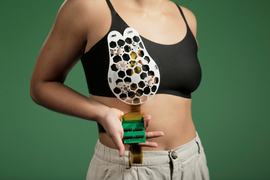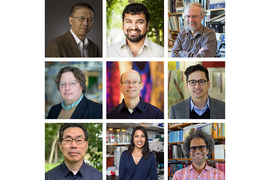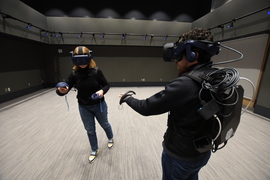MIT Provost Cynthia Barnhart has announced three Professor Amar G. Bose Research Grants to support bold research projects across diverse areas of study including engineering, animal behavior, and human movement.
This year's recipients are Kaitlyn Becker, assistant professor of mechanical engineering and the d’Arbeloff Career Development Professor in Mechanical Engineering; Canan Dagdeviren, associate professor and the LG Career Development Professor of Media Arts and Sciences; and Luca Daniel, professor of electrical engineering and computer science.
“Creativity and a willingness to take risks drive discovery and innovation, an approach that honors Amar Bose’s legacy of work,” says Barnhart. “These talented faculty members have the opportunity to push the boundaries of their fields of research thanks to the support of this program, which seeks to fund daring projects and ideas.”
The program was named for the visionary founder of the Bose Corp. and MIT alumnus, Amar G. Bose ’51, SM ’52, ScD ’56. After gaining admission to MIT, Bose became a top math student and a Fulbright Scholarship recipient. He spent 46 years as a professor at MIT, led innovations in sound design, and founded the Bose Corp. in 1964. MIT launched the program 11 years ago to provide funding over a three-year period to MIT faculty who propose original, cross-disciplinary, and often risky research projects that would likely not be funded by conventional sources.
Swapping stones for glass
Hundreds of millions of tons of material from construction and demolition — mostly concrete — make their way into landfills each year. To reduce this waste and turn to more renewable sources of building materials, Becker is making an unexpected suggestion: why not build out of glass?
Her proposal, “Ditching Stones for Glass Houses,” envisions design space and manufacturing technologies to produce strong, versatile, and recyclable glass structural blocks. Becker hopes that this research could even be expanded to serve future space missions by offering a way to turn the moon’s rubble-like ground cover directly into building materials on the lunar surface.
“While my research and publication history are predominantly in soft robotics, my expertise and research interest is more broadly the design and manufacturing of novel systems that leverage unique material properties, which often come with highly constrained design and manufacturing spaces,” she explains.
Becker’s interest in glass began in 2006 when she was a first-year student working in the MIT glass lab, and she is excited to combine that artisanal interest with her professional expertise. “This will be the most substantial project I’ve undertaken, with the greatest potential for positive environmental and societal impact.”
What’s the buzz?
The wearable sensors that Dagdeviren and students in her Conformable Decoders research group at the MIT Media Lab have been developing to track human health are getting a new purpose: to study the behavior of individual honeybees and how those behaviors add up to swarm intelligence.
In her proposal, “Conformable surface acoustic wave sensors to study swarm intelligence in honeybees,” Dagdeviren explains how she will work with material scientists, electronics engineers, and data visualization experts to develop a tiny and flexible sensor tag for each bee. They will also develop the hardware on the tag to allow its signals to be sent wirelessly and design the software to collect and combine data from the tagged bees.
The findings could help researchers document how climate change is impacting communication among bees, she notes. A better understanding of swarm intelligence could also provide new insights into how humans interact socially in individual-centered and multifaceted societies.
“While we have successfully deployed piezoelectric-based sensors for targeted medical interventions involving the human brain, heart, stomach, and limbs, designing wearable sensors for bees … is a new challenge for us, which makes it unattractive to traditional grant sources,” Dagdeviren says.
Excellence in human movement
Picture a shortstop perfectly slinging a ball to first base, a ballroom dancer stepping through the intricacies of the Viennese waltz, or a karate black belt moving effortless through a kata. Are there some fundamental principles behind all of these organized movements — no matter how they’re practiced?
That’s a question that Daniel hopes to answer with his proposal, “Investigating the Elements of Organized Human Movement.” He was intrigued by the question in part due to his own experiences as part of the U.S. and Italian national teams for ballroom dancing and the bocce world championships, and will be working with Armin Kappacher, head of the MIT ballroom dancing team.
The study will relate the properties of joints to more expansive properties such as “elegance of movement,” says Daniel. The goal is to propose a basis for composing organized human movement where external force is distributed efficiently throughout the body’s rigid bones and elastic connective tissues.
“Imagine now that human beings manage to understand the core principles behind organized movement and distill them to provide general education toward healthy movement,” he notes. “This kind of healthy movement education will not only protect us from injuries, but will also keep our brain and body more functional with age, thus improving the quality of human life, while reducing health-care burden.”










